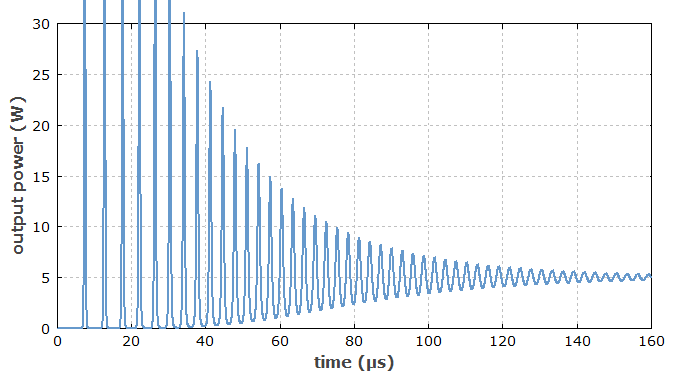spiking (original) (raw)
Author: the photonics expert (RP)
Definition: the tendency of some lasers to emit spikes of output power, particularly after being switched on
Category:  laser devices and laser physics
laser devices and laser physics
- laser physics
- cooperative lasing
- gain efficiency
- in-band pumping
- gain narrowing
- gain saturation
- Kuizenga–Siegman theory
- laser dynamics
- laser gain media
- laser transitions
- laser threshold
- lasing without inversion
- linewidth enhancement factor
- lower-state lifetime
- McCumber theory
- metastable states
- mode competition
- mode hopping
- modes of laser operation
- multiphonon transitions
- non-radiative transitions
- optical pumping
- output coupling efficiency
- parasitic lasing
- population inversion
- pulse generation
- radiation-balanced lasers
- radiative lifetime
- rate equation modeling
- reciprocity method
- relaxation oscillations
- single-frequency operation
- single-mode operation
- slope efficiency
- spatial hole burning
- spiking
- Stark level manifolds
- stimulated emission
- threshold pump power
- thresholdless lasers
- transition cross-sections
- twisted-mode technique
- ultrafast laser physics
- upconversion
- upper-state lifetime
- wavelength tuning
- (more topics)
Related: laser dynamicsrelaxation oscillationssolid-state lasersstabilization of lasers
Page views in 12 months: 693
DOI: 10.61835/cv6 Cite the article: BibTex BibLaTex plain textHTML Link to this page! LinkedIn
Content quality and neutrality are maintained according to our editorial policy.
Contents
What is Spiking of a Laser?
When the pump power of a laser (particularly a solid-state laser) is suddenly switched on, the laser output power may exhibit several spikes, i.e. energetic light pulses, before it approaches its steady-state value via relaxation oscillations, as shown in Figure 1. Similar effects occur when the resonator losses are suddenly reduced, after some time when the gain medium was pumped (→ Q-switching).
The duration of the first spike can be of the order of a few times the resonator round-trip time, and is thus often as short as a few tens of nanoseconds. Subsequent spikes then become longer and longer. The temporal spacing of the spikes is of the order of the inverse relaxation oscillation frequency.

Figure 1: Turn-on dynamics of a laser, simulated with the software RP Q-switch. It is assumed that the pump power is suddenly switched on. Before the steady state is reached, the laser emits a number of spikes and undergoes damped relaxation oscillations.

Figure 2: Phase space representation of the same dynamics as in Figure 1.
After turning on, the operating point starts a revolution along the outer curve in counter-clockwise direction, and then gradually approaches the steady state with smaller and smaller excursions of gain and output power.
Pronounced spiking occurs for lasers where the upper-state lifetime is much larger than the cavity damping time. This is the case for, e.g., solid-state lasers based on ion-doped crystals or glasses, particularly when built with a short laser resonator. Spiking may then be reduced, but hardly suppressed altogether, with electronic feedback systems. Gas lasers often operate in an entirely different regime, with the upper-state lifetime being substantially smaller than the cavity damping time, so that spiking phenomena do not occur.
Frequently Asked Questions
This FAQ section was generated with AI based on the article content and has been reviewed by the article’s author (RP).
What is laser spiking?
Laser spiking is a phenomenon where the output power of a laser shows several energetic light pulses (spikes) when the pump power is suddenly switched on. This is a transient behavior that occurs before the power settles to its steady-state value via relaxation oscillations.
Which types of lasers are prone to spiking?
Spiking is most pronounced in lasers where the upper-state lifetime of the gain medium is much longer than the cavity damping time. This is typical for solid-state lasers using ion-doped crystals or glasses, especially those with short laser resonators.
What is the connection between laser spiking and relaxation oscillations?
Spiking is the initial, large-amplitude phase of relaxation oscillations. The temporal spacing of the spikes is determined by the relaxation oscillation frequency, and the spikes represent the damped oscillations as the laser approaches its stable operating point.
How is spiking related to Q-switching?
Q-switching is a technique that intentionally exploits and controls the generation of a strong first spike. It involves suddenly reducing resonator losses after the gain medium has been pumped, leading to a single, powerful light pulse.
Questions and Comments from Users
Here you can submit questions and comments. As far as they get accepted by the author, they will appear above this paragraph together with the author’s answer. The author will decide on acceptance based on certain criteria. Essentially, the issue must be of sufficiently broad interest.
Please do not enter personal data here. (See also our privacy declaration.) If you wish to receive personal feedback or consultancy from the author, please contact him, e.g. via e-mail.
By submitting the information, you give your consent to the potential publication of your inputs on our website according to our rules. (If you later retract your consent, we will delete those inputs.) As your inputs are first reviewed by the author, they may be published with some delay.